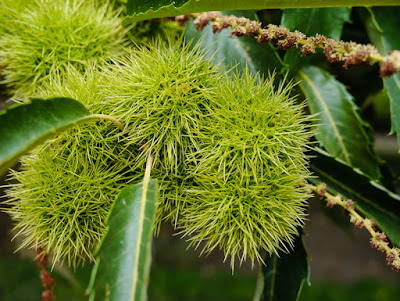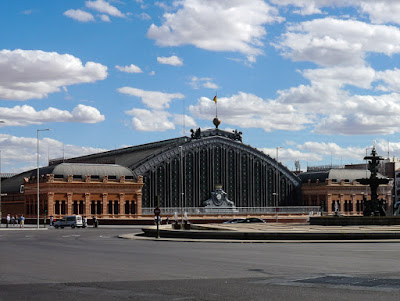Since our last blog post we finished our Northwest US and Canada road trip, spent time with our families, and most recently flew to Spain. We are traveling first in Madrid, and to help us get over jet lag we've been walking a lot. This is Cybeles Palace, the landmark symbol of Madrid. The building first was the post office headquarters, then a museum and became Madrid City Hall in 2007.

There's a lot of history in the capital of Spain. This is San Jerónimo el Real Catholic Church.

Madrid's history goes back to the 2nd century B.C. but most of the buildings that remain today were built in the 20th century. Turrets and domes are common on the grander buildings.

This sculpture is of a bear eating fruit from a strawberry tree. This symbol for this city dates back to the Middle Ages and is on the coat of arms.

Today the coat of arms adorns letter boxes, man hole covers and signs.

Being such an old city, many streets don't run perpendicular. The angled streets resulted in triangle shaped buildings. This turret has beautiful tile-work.

Some of the streets in Madrid are narrow, with only enough room for side walks and one lane of traffic. We especially liked looking down the curved, narrow streets here.

Locals here are known as Madrileños, and they traditionally take vacations during August. During the day the city feels very quiet and we saw lots of shops with signs like this.

Street signs are posted on the corner of buildings. Interestingly the images on the street signs don't relate to the name of the street; Abada means abbey, not rhino.

Neighborhoods can be colorful with modern paintings on buildings.

There are lots of impressive doors.


Even the small doors are often painted with graffiti or colorful signs.


We walked a lot in El Buen Retiro Park. This is the church of San Manuel and San Benito, which is just outside the park.

Our favorite street performers were a Flamenco dancer and guitarist.

El Retiro was mostly built during the 18th century by the Spanish royalty. Kristina is in front of The Great Pond where mock naval battles took place. Nowadays it has row boats. In the background is a monument to Alphonso XII.

Pete is peaking around a petunia flower tower.

There are lots of water features in the park like this gargoyle at the base of the Fountain of the Fallen Angel.

And here's the top of the fountain. The snakes have a hold on the angel and appear to be dragging him down to hell.

The botanical gardens in the park are lovely and filled with interesting trees and plants.

There was a photography exhibit including Julian Zabik's realistic photos. This one is called Barbed Wire.

We happened upon a Carle Andre exhibit that we had seen last summer at the Dia Beacon in New York. It was a treat to revisit it. Pete almost looks like he's floating in front of the floor sculpture Ferrox.

This is 25 Cedars Scattered / 25 Cedars Solid.

Madrid has lots of art museums so we had fun looking at all the artwork. This is the new wing of the Reina Sofia museum.

Inside the Reina Sofia we saw Equal Parallel: Guernica Benghazi by Richard Serra.

In the courtyard was Alexander Calder's Carmen. The red and yellow parts rotate in the wind.

We stayed in the La Latina district because we wanted to be in the heart of the Virgin of La Paloma festival. Legend has it that the painting performed several miracles in the late 19th century, so the festival was started for the patron saint of Madrid, the Virgin Mary.

Bars and restaurants in the neighborhood display the Virgin Mary painting above the entrance. This one had modern touches with green and white lights.

La Latina is a gay neighborhood, so this Virgin Mary is framed by a rainbow.

The festival includes traditional costumes like these dresses.

Flowers on their heads complete the look.

The men wear vests and hats made from black and white checked fabric.

This young boy had fun at the face painting booth.

Madrileños are known as gatos (cats) because of their late night habits. This gato is sporting a black and white checked hat in honor of the festival.

During the ten day festival some of the buildings are adorned with colorful decorations.

And around dusk people start gathering in the streets for the party. We joined in, and were struck with the beautiful light on the church as we strolled.

Streamers adorn the streets around the bars and restaurants where people congregate. The festival has a friendly and fun atmosphere.

Lights are strung in the plazas, enabling dancing into the wee hours.

Of course food is a big part of the fiesta, and there were lots of grilled meats as well as Spanish food and drink favorites.

These tapas are pulpo (octopus on toast), gilda (skewer of olives and anchovies) and sardinas (smoked sardines on toast).

Kristina is enjoying hanging out at Muñiz tapas bar.

Pete is about to dig into this plate of chicarones (a Spanish sausage that is kind of like a cross between copa and mortadella).

It was packed inside Casa Dani, but Kristina didn't mind because she got to eat these tasty anchovies topped with pimiento peppers.

We ate fresa y chocolate helado (strawberry and chocolate ice cream).

Pete is dipping churros into hot chocolate, a Spanish treat.

Look at all this jamon, Spanish ham!

The market and restaurant is appropriately named museo del jamon, Ham Museum.

Pete is nibbling on a jamon bocadillo, ham sandwich.

Next we will take a train from the Madrid train station to Malaga, where we'll stay for two weeks to do a Spanish immersion program.

Our next post will be in Spanish (with lots of photos)!

There's a lot of history in the capital of Spain. This is San Jerónimo el Real Catholic Church.

Madrid's history goes back to the 2nd century B.C. but most of the buildings that remain today were built in the 20th century. Turrets and domes are common on the grander buildings.

This sculpture is of a bear eating fruit from a strawberry tree. This symbol for this city dates back to the Middle Ages and is on the coat of arms.

Today the coat of arms adorns letter boxes, man hole covers and signs.

Being such an old city, many streets don't run perpendicular. The angled streets resulted in triangle shaped buildings. This turret has beautiful tile-work.

Some of the streets in Madrid are narrow, with only enough room for side walks and one lane of traffic. We especially liked looking down the curved, narrow streets here.

Locals here are known as Madrileños, and they traditionally take vacations during August. During the day the city feels very quiet and we saw lots of shops with signs like this.

Street signs are posted on the corner of buildings. Interestingly the images on the street signs don't relate to the name of the street; Abada means abbey, not rhino.

Neighborhoods can be colorful with modern paintings on buildings.

There are lots of impressive doors.


Even the small doors are often painted with graffiti or colorful signs.


We walked a lot in El Buen Retiro Park. This is the church of San Manuel and San Benito, which is just outside the park.

Our favorite street performers were a Flamenco dancer and guitarist.

El Retiro was mostly built during the 18th century by the Spanish royalty. Kristina is in front of The Great Pond where mock naval battles took place. Nowadays it has row boats. In the background is a monument to Alphonso XII.

Pete is peaking around a petunia flower tower.

There are lots of water features in the park like this gargoyle at the base of the Fountain of the Fallen Angel.

And here's the top of the fountain. The snakes have a hold on the angel and appear to be dragging him down to hell.

The botanical gardens in the park are lovely and filled with interesting trees and plants.

There was a photography exhibit including Julian Zabik's realistic photos. This one is called Barbed Wire.

We happened upon a Carle Andre exhibit that we had seen last summer at the Dia Beacon in New York. It was a treat to revisit it. Pete almost looks like he's floating in front of the floor sculpture Ferrox.

This is 25 Cedars Scattered / 25 Cedars Solid.

Madrid has lots of art museums so we had fun looking at all the artwork. This is the new wing of the Reina Sofia museum.

Inside the Reina Sofia we saw Equal Parallel: Guernica Benghazi by Richard Serra.

In the courtyard was Alexander Calder's Carmen. The red and yellow parts rotate in the wind.

We stayed in the La Latina district because we wanted to be in the heart of the Virgin of La Paloma festival. Legend has it that the painting performed several miracles in the late 19th century, so the festival was started for the patron saint of Madrid, the Virgin Mary.

Bars and restaurants in the neighborhood display the Virgin Mary painting above the entrance. This one had modern touches with green and white lights.

La Latina is a gay neighborhood, so this Virgin Mary is framed by a rainbow.

The festival includes traditional costumes like these dresses.

Flowers on their heads complete the look.

The men wear vests and hats made from black and white checked fabric.

This young boy had fun at the face painting booth.

Madrileños are known as gatos (cats) because of their late night habits. This gato is sporting a black and white checked hat in honor of the festival.

During the ten day festival some of the buildings are adorned with colorful decorations.

And around dusk people start gathering in the streets for the party. We joined in, and were struck with the beautiful light on the church as we strolled.

Streamers adorn the streets around the bars and restaurants where people congregate. The festival has a friendly and fun atmosphere.

Lights are strung in the plazas, enabling dancing into the wee hours.

Of course food is a big part of the fiesta, and there were lots of grilled meats as well as Spanish food and drink favorites.

These tapas are pulpo (octopus on toast), gilda (skewer of olives and anchovies) and sardinas (smoked sardines on toast).

Kristina is enjoying hanging out at Muñiz tapas bar.

Pete is about to dig into this plate of chicarones (a Spanish sausage that is kind of like a cross between copa and mortadella).

It was packed inside Casa Dani, but Kristina didn't mind because she got to eat these tasty anchovies topped with pimiento peppers.

We ate fresa y chocolate helado (strawberry and chocolate ice cream).

Pete is dipping churros into hot chocolate, a Spanish treat.

Look at all this jamon, Spanish ham!

The market and restaurant is appropriately named museo del jamon, Ham Museum.

Pete is nibbling on a jamon bocadillo, ham sandwich.

Next we will take a train from the Madrid train station to Malaga, where we'll stay for two weeks to do a Spanish immersion program.

Our next post will be in Spanish (with lots of photos)!